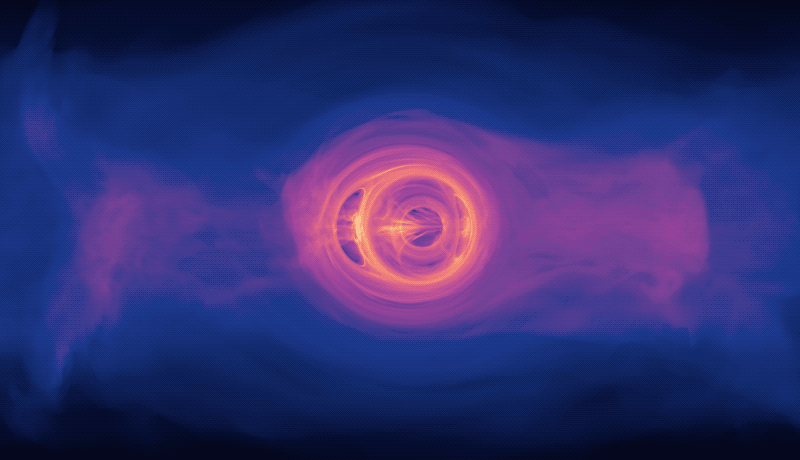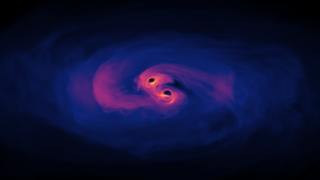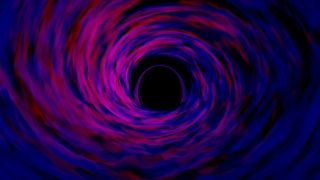Universe
ID: 13043
A new model is bringing scientists a step closer to understanding the kinds of light signals produced when two supermassive black holes, which are millions to billions of times the mass of the Sun, spiral toward a collision. For the first time, a new computer simulation that fully incorporates the physical effects of Einstein’s general theory of relativity shows that gas in such systems will glow predominantly in ultraviolet and X-ray light.
The new simulation shows three orbits of a pair of supermassive black holes only 40 orbits from merging. The models reveal the light emitted at this stage of the process may be dominated by UV light with some high-energy X-rays, similar to what’s seen in any galaxy with a well-fed supermassive black hole.
Three regions of light-emitting gas glow as the black holes merge, all connected by streams of hot gas: a large ring encircling the entire system, called the circumbinary disk, and two smaller ones around each black hole, called mini disks. All these objects emit predominantly UV light. When gas flows into a mini disk at a high rate, the disk’s UV light interacts with each black hole’s corona, a region of high-energy subatomic particles above and below the disk. This interaction produces X-rays. When the accretion rate is lower, UV light dims relative to the X-rays.
Based on the simulation, which ran on the National Center for Supercomputing Applications’ Blue Waters supercomputer at the University of Illinois at Urbana-Champaign, the researchers expect X-rays emitted by a near-merger will be brighter and more variable than X-rays seen from single supermassive black holes. The pace of the changes links to both the orbital speed of gas located at the inner edge of the circumbinary disk as well as that of the merging black holes.


New Simulation Sheds Light on Spiraling Supermassive Black Holes
The new simulation shows three orbits of a pair of supermassive black holes only 40 orbits from merging. The models reveal the light emitted at this stage of the process may be dominated by UV light with some high-energy X-rays, similar to what’s seen in any galaxy with a well-fed supermassive black hole.
Three regions of light-emitting gas glow as the black holes merge, all connected by streams of hot gas: a large ring encircling the entire system, called the circumbinary disk, and two smaller ones around each black hole, called mini disks. All these objects emit predominantly UV light. When gas flows into a mini disk at a high rate, the disk’s UV light interacts with each black hole’s corona, a region of high-energy subatomic particles above and below the disk. This interaction produces X-rays. When the accretion rate is lower, UV light dims relative to the X-rays.
Based on the simulation, which ran on the National Center for Supercomputing Applications’ Blue Waters supercomputer at the University of Illinois at Urbana-Champaign, the researchers expect X-rays emitted by a near-merger will be brighter and more variable than X-rays seen from single supermassive black holes. The pace of the changes links to both the orbital speed of gas located at the inner edge of the circumbinary disk as well as that of the merging black holes.


Source Material
Related
For More Information
Credits
Scott Wiessinger (USRA): Lead Producer
Jeanette Kazmierczak (University of Maryland College Park): Lead Science Writer
Scott Noble (USRA/U. Tulsa): Lead Visualizer
Scott Noble (USRA/U. Tulsa): Lead Scientist
Francis Reddy (University of Maryland College Park): Science Writer
Jeanette Kazmierczak (University of Maryland College Park): Lead Science Writer
Scott Noble (USRA/U. Tulsa): Lead Visualizer
Scott Noble (USRA/U. Tulsa): Lead Scientist
Francis Reddy (University of Maryland College Park): Science Writer
Please give credit for this item to:
NASA's Goddard Space Flight Center. However, individual items should be credited as indicated above.
NASA's Goddard Space Flight Center. However, individual items should be credited as indicated above.
Science Paper:
https://iopscience.iop.org/article/10.3847/1538-4357/aad8b4
Short URL to share this page:
https://svs.gsfc.nasa.gov/13043
This item is part of these series:
Narrated Movies
Astrophysics Visualizations
Astrophysics Stills
Astrophysics Features
Keywords:
SVS >> Music
SVS >> Simulation
SVS >> X-ray
SVS >> Black Hole
SVS >> Astrophysics
SVS >> Edited Feature
SVS >> Space
NASA Science >> Universe
SVS >> Supermassive Black Hole
https://iopscience.iop.org/article/10.3847/1538-4357/aad8b4
Short URL to share this page:
https://svs.gsfc.nasa.gov/13043
This item is part of these series:
Narrated Movies
Astrophysics Visualizations
Astrophysics Stills
Astrophysics Features
Keywords:
SVS >> Music
SVS >> Simulation
SVS >> X-ray
SVS >> Black Hole
SVS >> Astrophysics
SVS >> Edited Feature
SVS >> Space
NASA Science >> Universe
SVS >> Supermassive Black Hole














